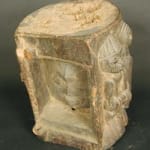Yoruba Wooden Ceremonial Altar, 19th Century CE - 20th Century CE
Wood
14 x 15.5
PF.4766
Further images
Steeped in tradition, African culture emerges with a plethora of Rites of Passage and ceremonies, combining religious beliefs and family ties. This particular altar usually demonstrates the strength of the...
Steeped in tradition, African culture emerges with a plethora of Rites of Passage and ceremonies, combining religious beliefs and family ties. This particular altar usually demonstrates the strength of the tribal family bond, while including musical harmony as a metaphor for life.
Simple in design, yet deep in meaning, the altar represents tribal unity through all phases of life, good or bad. The material used, a solid portion of wood, enhances the emotions revealed while at the same time creating an aesthetically pleasing appearance. Each character along the outer part is unique, whether in expression or action, thus accentuating the variety of life. The hidden door at the back of the altar contains the image of one of the deities worshipped by the Yoruba tribe. A powerful vision indeed, it's placing within the altar suggests a sense of supreme sacredness regarding this particular figure, adding greater importance to it. The size and gracefulness of its execution show every detail of the work of art that is incased within a work of art.
Its function becomes almost obsolete as we look at it, yet know that it helped to bring the community closer together by connecting them physically, and in turn, spiritually, without malice, but with rich tradition, unparalleled by anyone.
Simple in design, yet deep in meaning, the altar represents tribal unity through all phases of life, good or bad. The material used, a solid portion of wood, enhances the emotions revealed while at the same time creating an aesthetically pleasing appearance. Each character along the outer part is unique, whether in expression or action, thus accentuating the variety of life. The hidden door at the back of the altar contains the image of one of the deities worshipped by the Yoruba tribe. A powerful vision indeed, it's placing within the altar suggests a sense of supreme sacredness regarding this particular figure, adding greater importance to it. The size and gracefulness of its execution show every detail of the work of art that is incased within a work of art.
Its function becomes almost obsolete as we look at it, yet know that it helped to bring the community closer together by connecting them physically, and in turn, spiritually, without malice, but with rich tradition, unparalleled by anyone.









